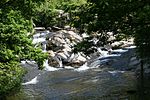Penrhyn Castle

Penrhyn Castle (Welsh: Castell Penrhyn) is a country house in Llandygai, Bangor, Gwynedd, North Wales, constructed in the style of a Norman castle. The Penrhyn estate was founded by Ednyfed Fychan. In the 15th century his descendent Gwilym ap Griffith built a fortified manor house on the site. In the 18th century, the Penrhyn estate came into the possession of Richard Pennant, 1st Baron Penrhyn, in part from his father, a Liverpool merchant, and in part from his wife, Ann Susannah Pennant née Warburton, the daughter of an army officer. Pennant derived great wealth from his ownership of slave plantations in the West Indies and was a strong opponent of attempts to abolish the slave trade. His wealth was used in part for the development of the slate mining industry on Pennant's Caernarfonshire estates, and also for development of Penrhyn Castle. In the 1780s Pennant commissioned Samuel Wyatt to undertake a reconstruction of the medieval house. On Pennant's death in 1808, the Penrhyn estate was inherited by his second cousin, George Hay Dawkins, who adopted the surname Dawkins-Pennant. From 1822 to 1837 Dawkins-Pennant engaged the architect Thomas Hopper who rebuilt the house in the form of a Neo-Norman castle. Dawkins-Pennant, who sat as Member of Parliament for Newark and New Romney, followed his cousin as a long-standing opponent of emancipation, serving on the West India Committee, a group of parliamentarians opposed to the abolition of slavery, on which Richard Pennant had served as chairman. Dawkins-Pennant received significant compensation when, in 1833, emancipation of slaves in the British Empire was eventually achieved, through the passing of the Slavery Abolition Act. In 1840, the Penrhyn estate passed to Edward Gordon Douglas, through his marriage to Dawkins-Pennant's elder daughter, Juliana. Douglas, who assumed the name Douglas-Pennant, was elevated to the peerage as 1st Baron Penrhyn of the second creation in 1866. He, and his son and heir, George Douglas-Pennant, 2nd Baron Penrhyn, continued the development of their slate interests at Penrhyn Quarry, and of the supporting infrastructure throughout North-West Wales. Firmly opposed to trade unionism at their quarries, their tenure saw bitter strikes over union recognition and workers' rights, culminating in the Great Strike of 1900–1903, the longest dispute in British industrial history. Little development took place at the castle, which was not the family's principal residence and was mainly used as a holiday home in the summer months, but the interior was enhanced by Edward Douglas-Pennant's creation of a major collection of paintings. These provided the setting for entertaining guests, who included Queen Victoria, her son the Prince of Wales and William Gladstone. The castle passed from the family to the National Trust via the National Land Fund in 1951. Penrhyn Castle is a Grade I listed building, recognised as Thomas Hopper's finest work. Built in the Romanesque Revival style, it is considered one of the most important country houses in Wales and as among the best of the Revivalist castles in Britain. Its art collection, including works by Palma Vecchio and Canaletto is of international importance. In the 21st century, the National Trust's attempts to explore the links between their properties and colonialism and historic slavery have seen the castle feature in the ensuing culture wars.
Excerpt from the Wikipedia article Penrhyn Castle (License: CC BY-SA 3.0, Authors, Images).Penrhyn Castle
Long Walk,
Geographical coordinates (GPS) Address External links Nearby Places Show on map
Geographical coordinates (GPS)
| Latitude | Longitude |
|---|---|
| N 53.2259 ° | E -4.0946 ° |
Address
Penrhyn Castle
Long Walk
LL57 4HW , Llandygai
Wales, United Kingdom
Open on Google Maps








